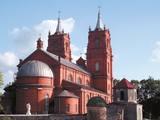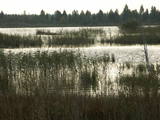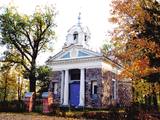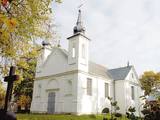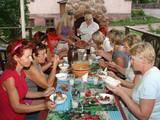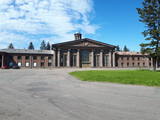| Нo | Название | Описание |
|---|---|---|
|
Saimniecībā tiek audzēti Helix Aspersa Maxima sugas gliemeži. Ekoloģiska produkcija. Tie tiek baroti tikai ar vietējiem dārzeņiem un gliemežiem domāto īpašo barību. |
||
|
Latvia’s highest hill is the second highest in the Baltic States, but alas, it has only a wrecked viewing tower, so you’ll have to look for the best views on your own. You’ll find some around the tower and the ski trails, particularly Large and Small Golgotha. It is worth hiking the Gaiziņkalns nature trail.
|
||
|
Mūsdienās redzamo (pēc skaita – trešo) baznīcu cēla laikā no 1835. - 1837. g. (ampīra stilā) Mārča Sāruma vadībā. Arī šīs ēkas projektēšanā par paraugu bija ņemts Pievolgas vācu baznīcu veidols, tādēļ tā līdzīga Dzērbenes luterāņu baznīcai. Dievnama altāri rotā Otto Donnera fon Rihtera glezna “Kristus debesbraukšana” (1898. g.). E. Martina firmā būvētās 10 reģistru ērģeles (1901. g.) darbojās arī šodien. Pie Drustu baznīcas atrodas 1932. g. atklātais un formās iespaidīgais (E. Kuraua firmas veidots) granīta piemineklis 1. pasaules karā un Latvijas Brīvības cīņās kritušo piemiņai. Nelielā baznīcas sienas nišā novietota piemiņas plāksne komunisma terora upuriem. |
||
|
Крестьянское хозяйство «Кайгари» находится в Бауском крае Межотненской волости. Специализация хозяйства – семеноводчество зерновых. В хозяйстве активно используют возможности поддержки, предоставляемой проектами ЕС. При помощи этой поддержки была приобретена современная сельскохозяйственная производственная техника. В общей сложности обрабатываются около 400 га. Их фруктового сада хозяйства открывается великолепный вид на долину Лиелупе. |
||
|
Даугава – самая большая река Латвии и судьбоносная река латышского народа. Уже по окончании ледникового периода по долине Даугавы на территорию Латвии «пришли» первые растения и животные, после которых последовал и человек. По этой причине берега Даугавы являются одним из древнейших мест обитания человека, а также одной из флорестически богатых территорий страны. Также большое количество выдающихся памятников культуры и истории является причиной, почему берега Даугавы так популярны у туристов. На участке Рига – Екабпилс удобным средством передвижения будет являться поезд железнодорожной линии Рига – Даугавпилс. Ниже указаны железнодорожные станции, на которых стоит выйти и отправиться в короткие – на несколько часов или полдня– радиальные походы с возвращением на станцию. Maršruta informācija no Latvijas Lauku foruma |
||
|
В «Унтуми» содержат и восстанавливают стадо лошадей, и покупают лошадей, которые исторически соответствуют требованиям породы коней, выведенной в Латвии. Здесь на ограниченной площади и на просторах можно научиться основам верховой езды в сопровождении инструктора. Летом предлагается катание в коляске, зимой - в подводе. Лошадей используют на свадьбах и на других торжественных мероприятиях. |
||
|
Наутренский (Роговский) Римско-католический костёл
Непорочного зачатия Девы Марии построен из кирпича в
романском стиле и c двумя высокими башнями (1901 – 1914 гг.)
вместо старого костёла. В 1939 году был приобретен орган –
памятник искусства.
|
||
|
Ventspils Vecpilsētas vēsturiskais centrs. Nelielā Rātslaukuma (40 x 60 m) rietumu malā atrodas Starptautiskā rakstnieku un tulkotāju māja, kas ierīkota 18. gs. dzīvojamā ēkā ar baroka un klasicisma iezīmēm (19. gs. vidū te atradās pilsētas Rātsnams), bet austrumu malā – vēlīnā klasicisma stilā celtā evaņģēliski luteriskā Nikolaja baznīca. Iepretim baznīcai atrodas modernā stilā pārbūvētā Ventspils Galvenā bibliotēka un Digitālais centrs, kas ierīkots greznā 19. gs. savrupmājā. |
||
|
The restricted area was set up to protect Nesaule Hill, which is a forested hillock in the area and features boreal and damp forests.
|
||
|
На пойменных лугах реки Падедзе и в окрестностях, на площади в 200 га выращивается ~ 350 благородных оленей, косуль и кабанов. На территории сада оленей построены вышки для наблюдения за грациозными лесными животными. Выкопаны пруды для коммерческой рыбалки. Экскурсии следует согласовать своевременно! |
||
|
Со стороны шоссе Рига – Даугавпилс (А6) (напротив кафе «Бордертаун») стоит необычный (построенный из складывающихся конструкций) храм, который изготовлен в Одессе в 1866 году. Церковь служила передвижной церковью царской армии и стоит на этом месте с 1904 года. Раньше (с 1886 г.) она находилась в Даугавпилсе. При храме построен деревянный дом-молельня, который открыт целые сутки. |
||
|
Парк усадьбы Ильзенберг отличается смешанной планировкой и сохранился в почти первозданном виде — таким, каким он был создан во второй половине XIX в. на живописном месте с выразительным рельефом, между озерами Апваласас и Ильгис. При восстановлении парка была сохранена его пространственная структура. Парк занимает 10 га и состоит из двух частей. Первая — это сравнительно правильная прямоугольная территория у дворца, ограниченная рядами сердцевидных лип и пейзажными группами местных и интродуцированных деревьев. Вторая часть представляет собой зеленые насаждения по типу естественного леса. Старый дуб из парка усадьбы Ильзенберг объявлен объектом природного наследия и находится под охраной государства. Охват ствола этого гиганта составляет 6,3 м, диаметр — 2 м, а высота — 30,5 м. |
||
|
Peat moss has been extracted from the Seda heath since the middle of the last century, but it is nevertheless one of the most important NATURA 2000 territories in Latvia, with a great diversity of landscapes, biotopes and biology – birds in particular. This is a good place for bird-watching during migration season, and viewing towers have been set up on the edge of the swamp for this purpose.
|
||
|
Илзескалнская-Кульневская православная церковь
построена в 1832 году владельцем усадьбы Илзенбергс (Илзес-
калнс) Михаилом Кульневым, братом Якова Кульнева. Церковь
представляет собой прямоугольное здание с полукруглыми выступами. Здесь похоронены члены
семьи Кульневых. Место захоронения – уникальный объект посещения, что является редким среди
православных церквей Латвии.
|
||
|
Karulas augstienes augstākais reljefa punkts (137 m.vjl.), kas virs tuvākās apkārtnes paceļas par ~ 60 m. Torņa kalnā ir uzbūvēts skatu tornis ar ļoti plašu apkārtskatu. Uz tā platformas ir novietoti panorāmas fotoattēli, kuros atzīmēti zīmīgākie plašākā apkaimē redzamie objekti – apdzīvotas vietas, pilskalni, baznīcu torņi u.c. Turpat izveidota atpūtas vieta un meklējams Rebases ainavu takas sākums. |
||
|
Одна из наиболее высоких дюн нашего побережья. В советское время в дюне велись копательные работы, так как песок использовался для производства силикатного кирпича. В 80-е годы ХХ века копательные работы были прекращены. Самая высокая часть дюны (хороший вид) сохранилась и поросла сосновым лесом. Создана природная тропа горы Пусену. Находятся в Бернатском природном парке. |
||
|
Каунатский Римско-католический костёл Пресвятой Девы
Марии построен в 1850 году на месте сгоревшего деревянного,
средства – помещицы Зузанны Друвы. В костёле находится икона
„Мария посещает Святую Элизабет”.
|
||
|
В Риге насладитесь прогулкой по Старому городу с его узкими мощеными улицами, районом Югендстиля, посетите Центральный рынок, чтобы ощутить местную атмосферу. На пути из Риги посетите Национальный парк Кемери, славящийся своими серными источниками. Пройдитесь по Кемерской болотной тропе. Отдохните в центре отдыха на озере Валгумс - Босоногая тропа, Лабиринт, купание в озере, спа-процедуры и отличный ресторан. Затем маршрут ведет в Музей Шоколада Пуре и сворачивает к древней долине реки Абава, где с 16 века выращивают виноград. Здесь находится малая часть исторического Винного холма, но есть и новые сады и виноградники, которые в последние годы сильно развились. Посетите Педвале – художественное пространство под открытым небом, а затем и живописную Кулдигу с ее хорошо сохранившимся деревянным зодчеством. В деревенском доме в Скрунде посмотрите, как выращивают грибы шитаки и отведайте блюда, из них приготовленные. Лиепая – энергичный город с его внушительным военным наследием, которое сейчас доступно каждому, красивым пляжем из белого песка. Здесь можно отведать особое блюдо – лиепайскую треску. Затем вас ждет визит на козью ферму и дегустация их продукции. Пройдитесь по крутым берегам Юркалне. Откройте для себя Вентспилс с его многочисленными парками, замком Ливонского Ордена, променадом, молом и хорошо оборудованным пляжем. Маршрут идет до места, где Рижский Залив встречается с открытым морем – на мыс Колка, а затем вдоль побережья к Риге. На пути посетите рыбаков в Энгуре. Понаблюдайте за процессом копчения рыбы и попробуйте ее на вкус. Посетите исторический морской и спа курорт Юрмалу с ее красивыми виллами 19 века, пообедайте в местном ресторане, специализирующемся на блюдах из картофеля. |
||
|
Корчма находится в центре столицы суитов Алсунге. Суиты всегда любили хорошо поработать, хорошо спеть и хорошо поесть! Хозяйки «Спелманю крогса» предлагают группам отведать приготовленные по старинным рецептам древних суитов блюда, а также всем вместе освоить приготовление скландраушей, клецок, скабпутры и других блюд этой стороны. Трапезу сделает незабываемой эффектное выступление женщин-суитов. Можете купить скландрауши и кислый хлеб, который пекут только у нас. Латышская кухня: Кисло-сладкий хлеб, клёцки, копченые рёбрышки. Особое блюдо: Домашние скландрауши. |
||
|
Spilves pļavas tika izmantotas kara aviācijas vajadzībām jau 1. Pasaules kara laikā. 1922. gadā bumbu sabojātā lidlauka atjaunošanu veica Latvijas Republikas Aviācijas divizions Jāzepa Baško vadībā. Drīz pēc tam Spilvē 51 hektāru lielā teritorijā pie Rīgas - Bolderājas dzelzceļa atzara un šosejas iekārtoja arī civilo lidostu, kuru no Rīgas pilsētas nomāja Latvijas Pasta un telegrāfa departaments. |
||






